Nintendo’s F-Zero – best Super Nintendo racer?
SNES racer “F-Zero” is thirty years old this year. It was first released back in November of 1990 in Japan. The start of the 1990’s marked the beginning of a time of great change for all forms of entertainment in the UK – from music to movies to gaming.

Yo VIP! Let’s Kick It!
And the biggest UK movies of the year were “Pretty Woman“, “Total Recall“, “Ghost” and “Back To The Future Part III.”
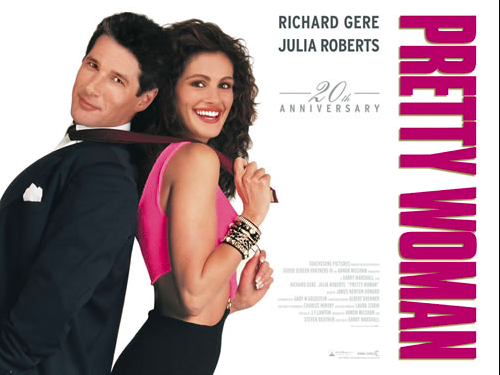
Three Thousand?
Maybe you remember going to see them at the pictures? – which is what we used to call going to the cinema back then.
Digital Days
When I think back to this time, I think of it as beginning of the switch from living in the ‘analogue world’ and moving towards living in a more ‘digital world.’ Those songs I mentioned above were all created and produced digitally. Music moved from the anlogue sounds of mixing and scratching and the early sampling of records towards fully digital production. Rhythms and beats were produced on computers and vocals were tracked over and over again using cutting edge digital music production software.
Purely Physical
Those movies were also some of the last analogue style big budget movies with mostly physical effects created by the use of clever make up effects, the use of models and miniatures as well as real physical sets and outdoor locations. Imagine how different a movie like BTTF would be today if the folks producing visual effects for the Marvel movies were working on them? To travel through time back then all you needed was a pretty unknown make of car and to set fire to two lines of petrol at 88mph…
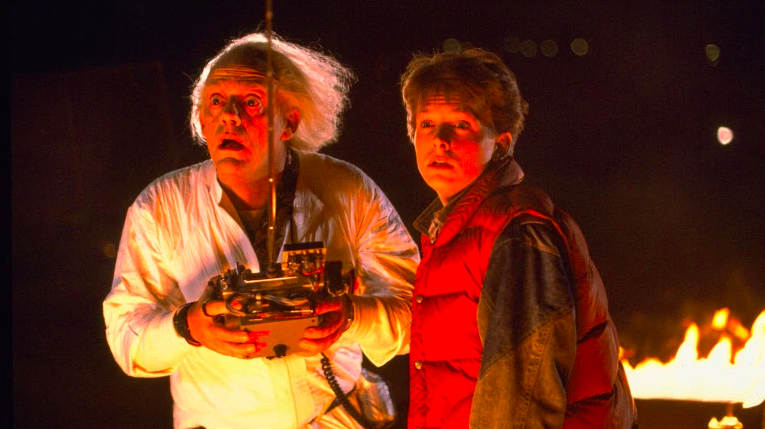
So glad it wasn’t a fridge!
But that’s enough Nineties talk or we’ll all be here too long. Let’s get back to gaming then and Nintendo’s super fast Mode 7 racer, F-Zero…
Console Concepts
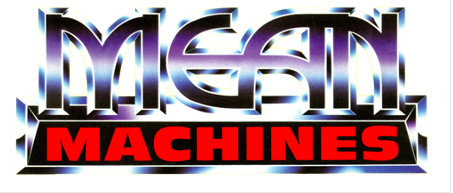
Shiny.
If you were a UK-based games fan in the early 1990’s then there was really only one magazine you needed to read. And that was EMAP’s “Mean Machines.” Spun out of a monthly double page spread in “Computer and Video Games’ – MM was THE place to go if you were interested in and excited about, the next wave of console gaming hardware heading to UK shores.

Still looks good today!
Sweet Sixteen Bits
There really was a time where the transition from the 16-bit computers to the 16-bit consoles seemed to take a long time. Most people were happily gaming away on their Commodore Amigas and Atari ST computers. But a smaller group was already dabbling in Nintendo or Sega games with the original 8-bit NES and Sega Master System consoles.
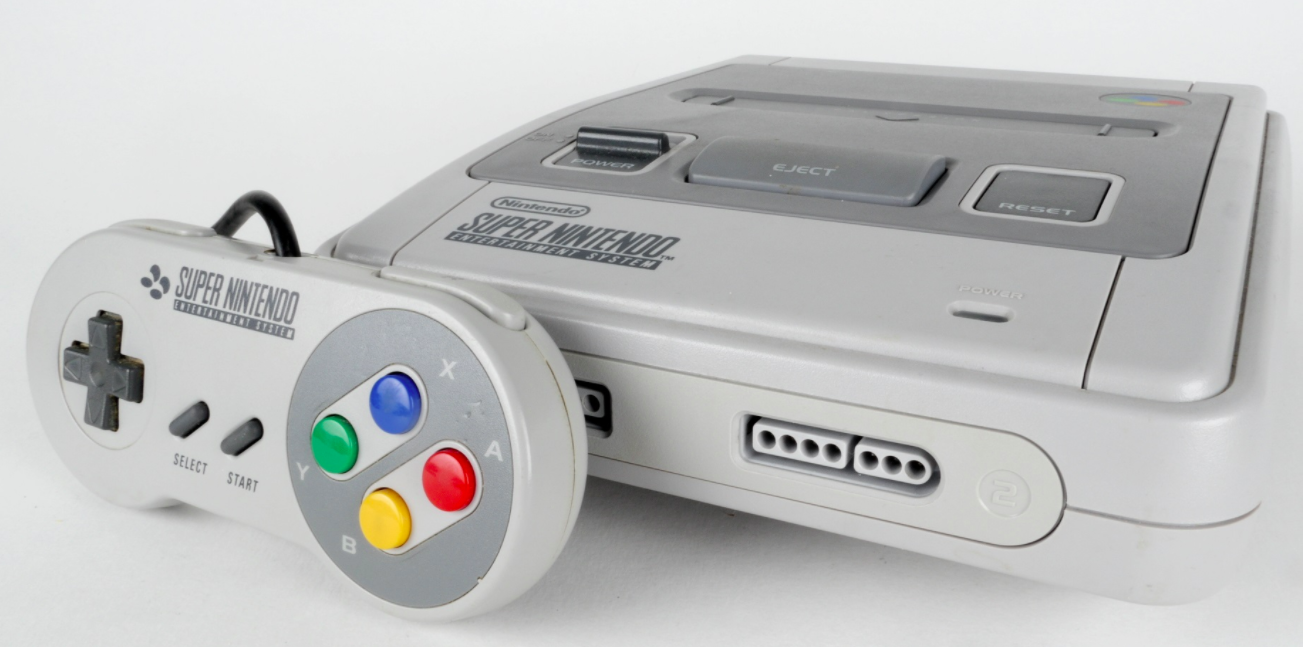
Is it Super NES or SNES?
Excitement soon began to build with word from overseas that both Sega and Nintendo had far more powerful 16-bit machines on the horizon. It was EMAP journalist Tony Takoushi who first championed the new console machines – writing first about the NES and Master System and later the NEC PC Engine. The baton was then passed to ex- Newsfield writer Julian Rignall who launched the dedicated “Mean Machines” magazine for EMAP in October 1990.
“Now You’re Playing With Power. Super Power.”
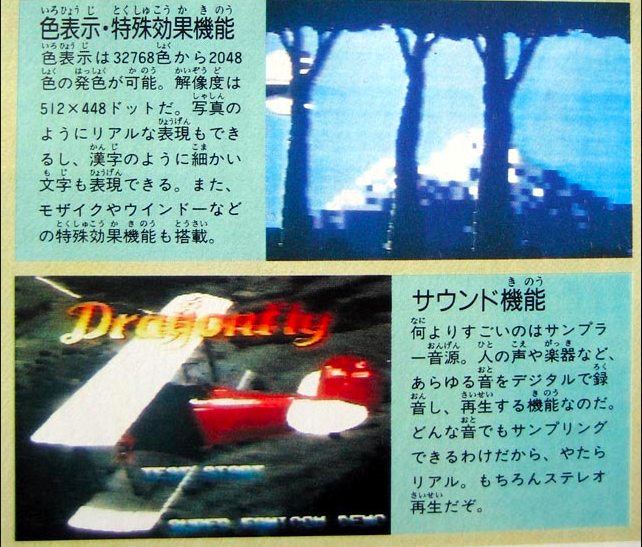
Always a sucker for a digitised image.
I think the first screenshots I ever saw about the new Nintendo console were of a flying game called “Dragonfly” (which later became “Pilotwings“) and of Capcom’s amazing sequel to their 1985 cult classic coin-op “Ghosts and Goblins” which was called “Ghouls and Ghosts.” These new machines offered more colours, sharper graphics and stereo sound. The machines looked amazing and word spread that finally we’d be able to own machines that would offer arcade quality games indistinguishable from their amusement arcade counterparts.

Is this the hardest game ever?
Mode Swings
Much like today there was a lot of discussion and speculation as to which machine was more powerful. Those types of discussion never really interested me. I was quite into Nintendo at the time, owning both a NES and a GameBoy handheld machine. But it soon became clear that whilst the Megadrive (or Genesis to you American readers!) had access to more American developed titles such as those coming out of Electronic Arts, the Nintendo machine had a very tasty hardware trick up its sleeve. And that trick had a name – Mode 7.
(If you were a dance music fan in 1991 or 1992 you’d be forgiven for thinking that Mode 7 was a new dance band with a song out in the charts. And if it was, they’d probably have a good dance beat, a nice piano break, and some club-style vocals!)
Effortlessly SFC
Mode 7 was one of seven video modes that made up the “picture processing unit’ of the Super NES hardware. (I could call it the Super Famicom (SFC) as it was known in Japan but I think it would only confuse people. But for any purists out there, rest assured that it we were drinking Asahi on the 24th floor of a highrise hotel in Makuhari, Japan in town for Tokyo Game Show then I most definitely would do.) It was Mode 7 that allowed the SNES to rotate things quickly and do some rather special ‘2D as 3D’ visuals. At the time, we’d just not seen anything like it.

Ultra Man? For the cover? Surely not!
Bottom Of The Ninth
By the time the ninth issue of “Mean Machines” hit the local newsagents it featured a review of a new Nintendo racing game called “F-Zero.” There had been a single colourful screenshot printed a few months earlier. And now here it was – the MM crew had got hold of an imported cartridge and reviewed the game.
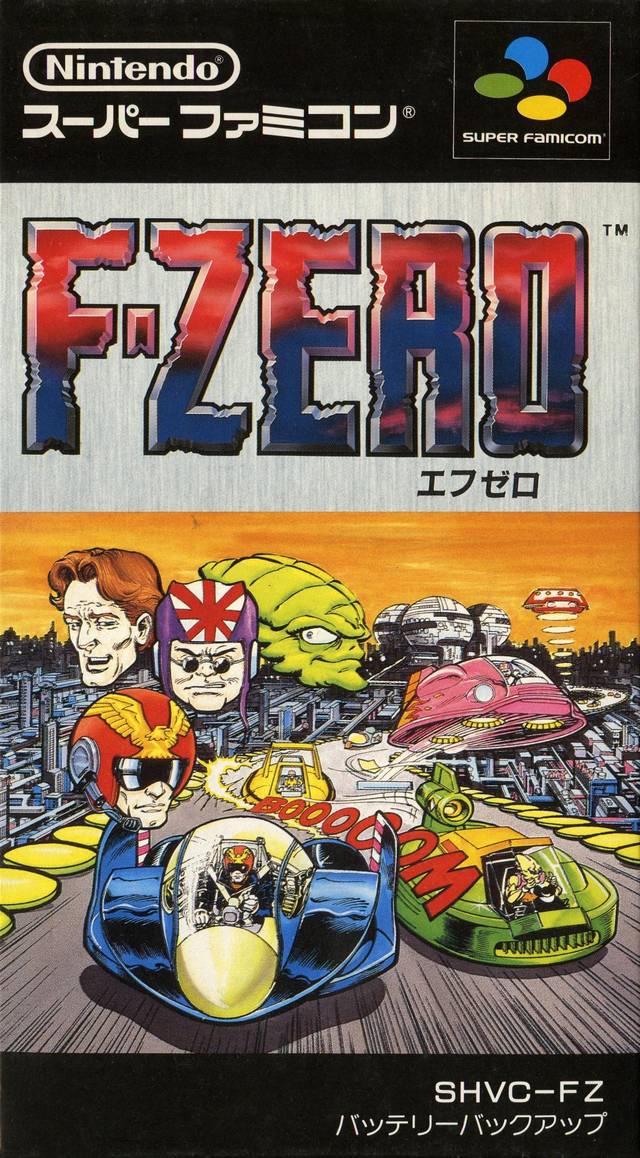
The Japanese boxes were always cooler.
The game took place on ‘Nu-Earth’ and the F-Zero Championship were the ‘fastest and most deadliest races’ around. In some ways, the world of F-Zero was probably the precursor to the Pod Racing sequence we were to see nearly a decade later in the first of the Star Wars prequel movie “Episode I‘. And you have to remember that at this time, the best racers had been stuff like Sqaure’s decent NES racer “Rad Racer“(which I wrote about HERE) or SEGA’s astonishing “OutRun” in the arcades (and for those of you keeping score at home, I wrote about that game HERE.)
Purple Bricks
So I first read about the game in Issue 9 of Mean Machines and then first got to see the game running several months later. I attended University in the United States in 1991 and the squarer styled purple coloured US version of the “Super NES” began shipping in limited quantities to US retailers in August of that year.
Clean Up In Aisle Nine
A friend of a friend blew some of his scholarship money on a machine and all of the games at the local K-Mart. “F-Zero” was one of those games. It didn’t much of a look in due to heavy play sessions on “Super Mario World“. The game was very very fast and quite hard to play. The sense of speed was like nothing else.
I didn’t play too much of the game back then. I waited until I got back to the UK the following year and picked up my UK spec machine from the local branch of Toys R Us. Along with the hardware I picked up “F-Zero” and “Smash TV.”
I think the game opened my eyes to what a truly fast and high speed experience a fast game could be. We’d just not seen anything like it before. And it wasn’t just only racing, it was fighting or battling as well. Success at the game relied on mastering the layouts of each course, and being able to catch all of the ‘boost pads’ to stay at top speed.
Not Under The Influence
Obviously, if you know the software I’ve directed and worked on over my career, you’d easily be forgiven for reading this and expecting me to write that “F-Zero” was somehow massively influential to me. In reality, it wasn’t. I think it was more an influence as to how home gaming technology was improving in great leaps.
And those leaps were going to bring us all much more closer to the sorts of games we’d been limited to playing in arcades. Of course, those arcade machines were all unique and were powered by custom dedicated hardware. The arcades offered a glimpse of the future. When we got home we adjusted to what we had.
Road Rage?
I actually took my copy of F-Zero back to Toys R Us two days later. I picked up Capcom’s “UN Squadron” instead. As a staunch fan of Atari’s “RoadBlasters” and “STUN Runner” in the arcades I think I was disappointed by the lack of shooting action in the Nintendo game. Or maybe I just really wanted to smash the other racers right off the track?
Jump Started
Futuristic syle racers have never really grabbed me that much – Well apart from the time I first laid eyes on Williams Star Rider which you can read about HERE. The game was fast and fun, but I think jumping over gaps in the track was more fun in games like “Bump N Jump” than it was in “F-Zero” and I wrote about that 1982 game HERE.
I think I prefer a bit of four wheel racing action to keep me truly hooked. Plus when the speed gets really really high, then the braking effect is often super strong as well. For me it takes away the driving feeling and it becomes more of an exercise in steering.
Bulked Up
I was much more interested in the 1998 Nintendo 64 follow up “F-Zero X” when it came out. I think the more spectacular 3D tracks made for a better game. Again, I don’t remember playing it that much, but it did make me see the game as a spiritual follow up to “STUN Runner” – running on faster hardware and a far more comprehensive game.
That game was enhanced for the N64 ‘bulky drive’ add-on. I got to see the 64DD development kit up at the Iguana UK office. It never came out in the West so no-one had one really. They were going to use it to make the N64 version of “Shadowman” look closer to its PC counterpart. Not sure they ever did in the end.
Plastic Surgery
At the time I was very interested in the idea that games that could be released and then be enhanced further post-release. It’s something we take for granted these days. It would be close to a decade later before that sort of thing would ever become commonplace. And then I’d be doing it myself with a huge team trying to push the boundaries of what could be achieved.
“Greetings, Starfighter…”
I think that if you’re going to make a futuristic racer then there is huge potential to be creative with it. I’d want to go to places I’ve never even imagined. Then, I want to race on tracks that are fantastical. There’s probably an exciting blend of science fiction world and racing game waiting to be made by someone. (Let’s hope someone else does it!)
I think there’d have to be weaponry of some sort in there, and the craft would have to be quite incredible. I enjoyed the Episode One “Pod Race” sequence, but I didn’t like the crafts in them. And I enjoyed the ‘Speeder Bike” sequence more back in 1983 – who didn’t?
Zero Sum Game
There’s one last anecdote to mention when it comes to “F-Zero.” Back in January 2012, I was working for another company on a racing game when the phone rang. It was a junior marketing guy from Nintendo’s UK office in Windsor. He asked me if ‘there was any chance’ we could do a new “F-Zero” for them. And if so, ‘could you be ready to show it at E3 in June?” Because they were short of games coming to their Wii U hardware. The UK guys had been brainstorming and putting trying to match Western developers with Nintendo owned intellecutal property.
To some people I’ve met, this seems to be super exciting to them. Well, calls like this happen a lot in the games industry. There are always speculative calls from publishers. It used to happen a LOT more a long time ago. The industry was seemingly driven by licensed properties for a good two decades. The strategy really was ‘sell what is on the box, not what is in the box.’
Other things I got asked about doing over the years were: “a true motorsports simulator” for Xbox, “a new Mad Max game called Fury Road” – a good eighteen years before the film ever came out, “a “Days Of Thunder game but set entirely in the UK” (can you guess why I said no?) and last but not least, “the officially licensed Vauxhall car game.” And these are the ones I’ll mention because they each make me smile.
I may have had a Cavalier (!) attitude to these proposals, but I have always been firmly focused on creating games that us, as the developers of them, had FULL creative control over. Working for someone else, on someone else’s stuff presents a huge set of challenges. In my experience, those challenges always slow down development, restrict the development team, and often you get a weaker game as a result. Besides, a game full of Vauxhall Corsas anyone?
Whilst you’re here, if you haven’t already please consider signing up to our Dangerous Driving Club
– we promise we’ll make it worth your while. If you love arcade racing games, then that’s great! because we do too!